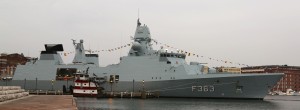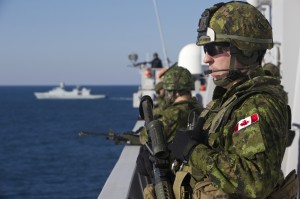2014-11-16 Visiting the HDMS Niels Juel: An Interview with Commander Lars Holbaek
Second Line of Defense visited the new Danish frigate, the HDMS Niels Juel, which had just participated in Bold Alligator 2014, and which constituted its first overseas engagement.
We interviewed Commander Lars Holbaek about his ship, its capabilities, the way ahead and his involvement in Bold Alligator 2014.
Commander Senior Grade Lars Holbaek was born in Copenhagen, Denmark, January 11, 1966.
He began his military career in 1988. After graduating from the Naval Academy in 1993,
Lars Holbaek served in various positions on board vessels of the Royal Danish Navy as well as being an instructor.
From 2000-2003, he took command of HDMS RAVNENE (Flyvefisken-class patrol vessel) until joining the Joint Senior Staff Officers Course at the Royal Danish Defence College, and then moving on the Danish Defence Command as a staff officer in Force Structure Branch (Planning Department).
Since then, Holbaek has served as Military Advisor to the Danish Chief of Defence, preparing briefings, decision presentations and planning and executing of the Generals visits to the Danish Forces in international operations in Kosovo, Iraq and Afghanistan.

He also served as head of Structure and Organization Branch at Admiral Danish Fleet in Aarhus, then moving on to become Head of Personnel Strategy Branch in the Danish Defence Staff.
In 2013, Holback assumed command of HDMS Iver Huitfeldt and then switched to HDMS Niels Juel in 2014 in order to prepare the second frigate in Division 21 to action state. The ship is the second frigate in a new class of three frigates
The frigate is an impressive ship, which is designed to perform multiple missions, including anti-submarine and air defense missions, and practiced both missions with the USN and coalition partners in Bold Alligator 2014.
That indeed, was why the ship was in the United States, and the visit constituted the new frigate’s first overseas deployment.
The baseline cost of the ship is just over $300 million with the full up capability of a fully enabled frigate around $900 million. It has a speed of 29 plus knots and endurance of more than 9000 nautical miles at 18 knots and a crew size of 116
The combat system C2 system can be adjusted to the mission sets to allow for greater capabilities for the particular mission sets as well.
The ship is based on the flex concept in all Danish naval ships built in this century whereby design elements among different ship classes are reused throughout the fleet. The same Combat Management System is common throughout the larger ships and standard racks are used for all weapon, sensors, communication and IT systems in all larger ships.
It leverages coalition technologies, from Germany, and the Netherlands and uses common technologies for its torpedo and radar systems.
It also leverages US technology like the MK-41 launcher tube, and can accommodate SM-2s if desired. Because it is a frigate, the ship can draw upon the global market for enabling frigates, a robust and evolving set of capabilities by allies in Europe and beyond.
The deck can hold a single helicopter of up to 20 tons, and the Danes are buying new Seahawk helos which will operate off of the ship.
A briefing by Cdr. S.g. Per Hesselberg, Project Manager of the Danish Frigate Program, explaining the approach which was given to the USN in May 2014 can be seen below:
Commander Holbaek: “This is our first overseas deployment and first overseas exercise.
We are here to participate in Bold Alligator 2014.
We operated in the exercise to protect the amphibious task force in both Air Defense and an ASW role.
We were under the command of the Dutch command ship and worked with USN destroyers for both Air Defense and ASW operations.”
Question: The ship is very flexible. When I was Denmark, there was discussion of fitting the ship with SM-2 missiles but the point really is that the ship is able to evolve with mission sets required for the strategic environment?
Commander Holbaek: That is true.
The CEC system is very flexible for you can shift roles and the network can support different uses.
You can plug into the network with the consoles and use them for the desired role.
The missile containers are also quite flexible. For example, the MK-41 system is inherently a flexible launch system.
The flight deck can hold a medium sized helo, up to 20 tons. The largest would be the UK Merlin helicopter. We are switching from the old Lynx to the Sea Hawk. The Danish Air Force is buying nine of them.
http://www.youtube.com/watch?v=6gekVpBnVIg
This was one of the benefits from the exercise as well was to work with the USN with regard to the Sea Hawk. We have not bought the ASW capability with the helo but the other capabilities will come with the new helo.
https://sldinfo.com/the-rotorcraft-the-carrier-and-training-for-strike-integration/
Question: What is your background and its relevance to this ship?
Commander Holbaek: I have significant experience in the Baltic sea and as a Navy we have a lot of experience in littoral operations.
It is not just about the technology, but the tactics, training and operational experience to really understand how to operate effectively in close in waters, and this frigate will be an important capability to do so.
Question: What role do you see this ship playing in Baltic defense?
Commander Holbaek: It is a natural with the anti-air and anti-submarine capability.
We have the capability to use our radars for missile defense and can tap into the SM-class of missiles as well.
And we are designed to work well with our Flex ships which have good capability to work with the frigates as an integrated package as well.
Question: What was your experience at Bold Alligator, which is an exercise, trying to sort out new ways to innovate in littoral operations?
Commander Holbaek: We are used to operating in shallow waters.

Danes are very used to operate in confined or closer in waters.
We can be a considered a very good partner in doing amphibious operations of the sort being tested in Bold Alligator.
Operating with asymmetric threat like small boats is an area in which we work regularly. If you are dealing with an asymmetric threat in confined waters, you need to know what you are doing.
It takes a lot of training and having the right tactics.
A main issue remains working connectivity among the allied forces.
Even with the NATO procedures, we need to work harder on getting common C2 procedures and technologies.
Otherwise one is reduced to the mission your ship will do rather than how you contribute to the overall operation in an integrated manner.
We need to re-shape the planning function as well.
Rather than using new technologies to make planning more detailed and complicated, we need to enhance the flexibility of key assets to execute an overall plan, rather than providing detailed tasking’s to each platform.
For our look at the evolving Danish defense challenge see the following:
https://sldinfo.com/european-defense-the-arctic-and-the-future/
For additional Bold Alligator 2014 stories see the following:
https://sldinfo.com/coastal-riverine-squadron-four-in-bold-alligator-2014/
https://sldinfo.com/joint-high-speed-vessel-in-bold-alligator-2014/
https://sldinfo.com/bold-alligator-2014-long-range-raid-to-support-embassy-under-seige/
https://sldinfo.com/bold-alligator-2014-shaping-insertion-forces-for-crisis-response/
https://sldinfo.com/bold-alligator-2014-training-to-support-an-embassy-under-threat/
https://sldinfo.com/bold-alligator-2014-osprey-insertions/
https://sldinfo.com/lcacs-in-bold-alligator-2014/
https://sldinfo.com/lcac-departure-from-uss-arlington-during-bold-alligator-2014/
https://sldinfo.com/looking-back-and-looking-ahead-from-bold-alligator-2013-to-2014/
https://sldinfo.com/re-shaping-coalition-insertion-forces-bold-alligator-2014/
For a look at LCS versus frigates, including the Danish frigate see the following:
http://warontherocks.com/2013/08/getting-our-moneys-worth-lcs-vs-iver-huitfeldt-class/
http://news.usni.org/2014/02/25/whats-next-lcs
http://noticiarionaval.blogspot.com/2008/07/lcs-so-why-doesnt-usa-clone-absalon.html


